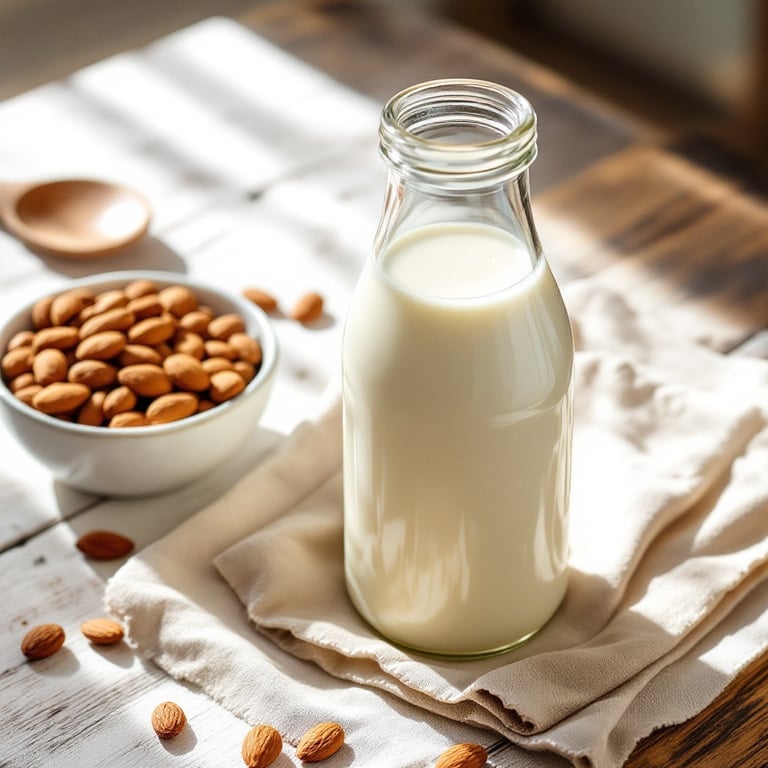How to Make Almond Milk
Almond milk is a nutritious and versatile plant-based alternative to cow's milk. Making almond milk is easy and only requires a few ingredients.
PLANT-BASED MILKEASY TO MAKE
2/27/20255 min read


A Brief History of Almond Milk
Almond milk has ancient roots, dating back centuries. It is believed to have originated in the Middle East and Mediterranean regions, where almonds have been grown for thousands of years. The earliest known record of almond milk can be traced to the 9th century, particularly in Arabic-speaking regions. Almond milk was commonly used as a substitute for dairy during times when fresh milk was hard to obtain, especially in the heat, where dairy spoiled quickly.
In medieval Europe, almond milk became a popular alternative to cow’s milk, especially during religious fasting periods when animal products were restricted. It was favored in the Middle Ages as a "milk" for monks during Lent or other religious observances, where they abstained from animal products. Because it was plant-based, it was seen as a permissible option.
Almond milk’s popularity continued to grow as people sought plant-based alternatives, especially with the rise of veganism, lactose intolerance awareness, and interest in dairy-free diets in the 21st century.
Health Benefits of Almond Milk
Almond milk is a nutritious and versatile plant-based alternative to cow's milk. Some of its health benefits include:
Low in Calories: Almond milk is low in calories compared to cow's milk, making it a great choice for those looking to reduce calorie intake.
Lactose-Free: Since almond milk is plant-based, it is naturally lactose-free, making it an excellent alternative for people with lactose intolerance.
Rich in Nutrients: Almond milk is often fortified with vitamins and minerals, including calcium, vitamin D, and vitamin E. These nutrients are essential for strong bones, immune support, and skin health.
Heart Health: Almond milk contains healthy fats (unsaturated fats), which are beneficial for heart health. The monounsaturated fats help reduce bad cholesterol levels and may lower the risk of heart disease.
Rich in Antioxidants: Almonds are packed with antioxidants, especially vitamin E, which helps protect your cells from oxidative stress and supports skin health.
Good for Weight Management: Almond milk can be a good option for weight management since it is low in calories and does not contain the saturated fat found in full-fat dairy products.
Promotes Digestive Health: Almond milk is easy to digest and is gentle on the stomach, making it an excellent option for individuals with sensitive digestive systems.
May Help Control Blood Sugar: Since almond milk is low in carbohydrates, it has a minimal effect on blood sugar levels, making it a great choice for people managing diabetes.
Almond Milk Recipe
Making homemade almond milk is easy and only requires a few ingredients. Here is a simple recipe to get you started:
Yield: 3-4 servings
Ingredients:
1 cup raw almonds
3-4 cups filtered water (depending on desired consistency)
1-2 tbsp sweetener (optional) – maple syrup, agave, pitted dates or honey
1 tsp vanilla extract (optional)
Instructions:
Soak the Almonds: Place the almonds in a bowl and cover them with water. Let them soak for at least 12-24 hours. This softens the almonds, making them easier to blend and results in a creamier milk.
Drain and Rinse: After soaking, drain and rinse the almonds thoroughly.
Blend the Almonds: Add the soaked almonds to a high-speed blender, along with 3-4 cups of water (depending on how thick or thin you want the milk). If you want to sweeten the milk with pitted dates, add them now. Blend on high for 1-2 minutes, until the almonds are fully blended and the liquid appears smooth.
Strain the Milk: To separate the almond milk from the almond meal, use a nut milk bag, fine mesh strainer, or cheesecloth. Place the strainer or bag over a large bowl, pour the blended mixture through it, and press to extract as much milk as possible.
Sweeten and Flavor (Optional): If you want sweetened almond milk, add your desired sweetener (like maple syrup or honey) and vanilla extract to the milk, and stir to combine.
Store: Transfer the almond milk to a sealed jar or bottle and refrigerate. It will last for 3-4 days. Be sure to shake it before using, as it can naturally separate over time.
Note:
If you are using almond milk in recipes and want a creamier texture, you can blend in some soaked cashews or oats with the almonds before straining. This will create a thicker milk.
Almond milk is a nutritious, dairy-free, and versatile beverage that can be used in countless ways, from cooking to baking to drinking on its own. Whether you are avoiding dairy or just looking for a lighter alternative, almond milk is a fantastic choice.
Fortifying homemade almond milk with calcium, vitamin D, and vitamin E is a great way to boost its nutritional content and make it a more complete alternative to cow's milk. Since homemade almond milk does not naturally contain significant amounts of these nutrients.
After making almond milk, you are left with a moist almond meal or almond pulp that can be used in a variety of ways rather than being thrown away. You can dry the almond meal and use it in baking or as a filler for other dishes.
Suggestions on How to Serve Almond Milk
Almond milk is incredibly versatile and can be enjoyed in many ways:
In Coffee and Tea: Use almond milk as a creamer for your coffee or tea. It adds a mild, nutty flavor that pairs well with coffee or tea blends. It’s especially delicious in lattes and cappuccinos.
Smoothies: Almond milk is an excellent base for smoothies. Combine it with fruits, greens, and protein powder for a healthy breakfast or post-workout drink.
Baking: Substitute almond milk for cow’s milk in recipes for baked goods like muffins, cakes, and pancakes. It works well in most recipes and adds a subtle, nutty flavor.
Cereal or Oatmeal: Pour almond milk over your favorite cereal or mix it into your oatmeal for a creamy, dairy-free alternative.
In Desserts: Use almond milk in desserts like puddings, ice cream, or chia seed pudding. It provides a rich texture without the dairy.
Savory Dishes: Almond milk can be used in savory dishes as well, like in cream-based soups, sauces, or casseroles as a dairy-free alternative to heavy cream or milk.
Hot Chocolate: Make a cozy dairy-free hot chocolate by mixing almond milk with cocoa powder, a sweetener, and a dash of vanilla.
Milkshakes: Blend almond milk with ice cream or frozen fruit for a refreshing, dairy-free milkshake.
As a Drink: Simply drink almond milk on its own, chilled, or warmed up with a dash of cinnamon for a comforting treat.
Who Should Avoid Almond Milk
While almond milk is generally considered safe for most people, there are a few groups who should be cautious or avoid it:
Allergy to Tree Nuts: People with an almond allergy should avoid almond milk, as it can trigger allergic reactions ranging from mild symptoms like hives to severe anaphylaxis.
Those with Nutritional Deficiencies: If almond milk is consumed as a main dairy alternative, make sure it is fortified with essential nutrients like calcium, vitamin D, and B12. Without fortification, it might not provide adequate nutrients, especially for vegans.
Important: If you have any doubts about incorporating this food into your diet, it is always a good idea to consult with your dietician or doctor.
Plenitaste
Inspiring healthy, global recipes for everyone.
contact me:
Recipe
plenitaste@gmail.com
© 2025. All rights reserved.
